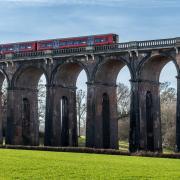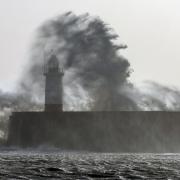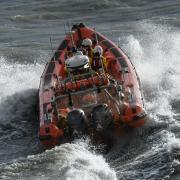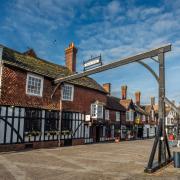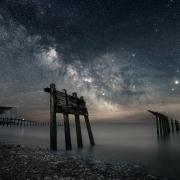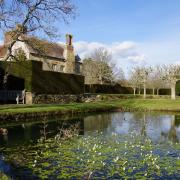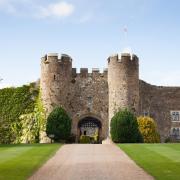As kids growing up by the carefree beaches of the Irish east coast, my friends and I would regularly cycle the short distance to the unspoiled sand dunes that tumbled down to the mouth of the river Boyne.
There, perched among the Marram grass, were three unusual estuarine lighthouses: Drogheda North, East and West lights were truncated structures that stood like daleks on stilts, gazing forlornly out to sea and only coming to life as the dusk crept in and we reluctantly set out bikes towards home.
Those beacons guided shipping past the coastal sand banks and into the safety of the channel and onward to port. I didn’t realise it at the time, but they imprinted in me a deep-seated love of lighthouses and all that they represent: a sense of the romance and adventure of life at sea and a reassuringly benevolent presence when illuminated at night. That very real sense of solace and reassurance has remained with me ever since.

Early in 2017, inspired by iconic railway posters of the 30s and 40s, I started illustrating some of the lighthouses along Ireland’s south coast. This quickly grew into a collection that culminated in an award-winning book Lighthouses of Ireland. During this time, I spent a holiday in Cornwall which spurred me to consider painting some of the lighthouses on the Cornish and Devon coasts. Before you knew it, I was pouring over maps from Sussex to Scotland.
The collection now runs to more than 350 lighthouses and a selection of these will appear in my new book Lighthouses of Britain and the Isles which will be published by Watkins next spring in 2024. The collection is not by any means complete, but bit by bit the missing pieces will be added, creating a comprehensive compilation of our best loved sentinels and beacons.

The Sussex coast has thrived on trading and fishing since the Romans first established ports at Chichester and Littlehampton. During the medieval period, towns such as Rye, Winchelsea, and Hastings became important centres of trade and fishing, with ships regularly travelling to France and other parts of Europe. For much of this time, aids to navigation relied on sailors recognising a familiar landmark such as a tower or hillside by day or the welcome sight of a candle set high up in a church tower window at night.
With the arrival of the industrial revolution, coal, bound from the north-east for manufacturing hubs on the south coast vastly increased maritime traffic alongside expanding trade in ports such as Newhaven and Hastings alongside leisure traffic to and from France. Around 1691 demands were made for a lighthouse to be built because of the number of shipwrecks occurring along the dangerous stretch of coast around Beachy Head.

The Belle Tout
But until the 1800’s the only light available to mariners off the East Sussex coast was the Owers lightvessel. In 1828, John ’Mad Jack’ Fuller built a temporary wooden lighthouse on the cliffs at Belle Tout. It commenced operation on the 1 October 1828 and was such a success that plans were soon afoot to build a more permanent structure. Construction started in 1832 and soon the 47ft tall circular granite tower was ready to begin operation. The lighthouse was positioned 100ft from the edge of the cliff and its flashing white light could be seen for 23 miles, weather permitting. Therein lay its Achilles’ heel. Set at a height of 250 ft above sea level, it was as often as not obscured by fog and sea mist. By 1899 plans for the Beachy Head lighthouse below the cliffs were at an advanced stage and the Belle Tout was retired.
Beachy Head Lighthouse
For three long years, while the granite blocks to complete Beachy Head Lighthouse were hoisted down by cable from the cliff top, this part of the Sussex coastline again relied on a lightvessel to provide illumination for passing shipping. The 142ft tapering tower with gallery and lantern was completed in 1902. The masonry courses were built in a stepped fashion to a height of 45ft and the tower with its seven floors was painted white with a broad black horizontal band - this was changed to red in 1951 to improve its visibility as a day mark against the white cliffs.
Royal Sovereign Lighthouse
About 12 km east of Beachy Head sits the now decommissioned hulk of the Royal Sovereign lighthouse. It hardly fits anyone’s description of a rocky sentinel, resembling instead some diminutive version of an oil exploration platform. It is, in fact, a perfect example of a carefully engineered piece of maritime architecture. Built in two parts on Newhaven beach, and first put into operation in 1971, it was designed to have lifespan of 50 years. It was retired in 2022, 51 years later. It had replaced the lightvessels that had provided illumination at the Royal Sovereign shoal or sandbank since 1875.
The structure was put together on site in two distinct operations. First, the base and attached column were floated out to the shoal, where the hollow base was flooded and allowed to sink into position. Then the cabin section and superstructure were floated out, positioned over the base, and allowed to settle on to the column as the tide fell.
Shoreham Lighthouse
To the east of the county, Shoreham, despite being used as a port in the Roman era, hadn’t really developed its harbour facilities until the current entrance was excavated in 1816 and it took a further century before the breakwaters that protect the harbour from shingle build-up were constructed.
The handsome limestone lighthouse tower dates from 1846. It is topped with a black lantern and stands just off Brighton Road near the Lifeboat Station. It operates in tandem with a front light situated in a black box on the roof of the Shoreham Port Authority watchtower. Its flashing white light is visible for 10 miles.

Newhaven Lighthouse
A little further east is the (in stormy weather) spectacular Newhaven breakwater and its white and red lighthouse dating from 1891. There have been a number of lighthouses on Newhaven’s piers. An earlier lighthouse, a circular stone-built structure from 1883, was demolished in 1976 after the pier almost collapsed. Another rather handsome if slight, wooden tower on the East Pier was dismantled in 2006 after the harbour authority fought a losing battle against vandals determined to wreck it. Today, as if to drive home the message that if we don’t take extraordinary steps to preserve our maritime built heritage, it will disappear for good, the old East Pier light has been replaced by a functional aluminium pole topped with an array of green LEDs flashing every ten seconds.
While at their core, our lighthouses are simply towers and beacons, they have captured the imagination in a way that few other buildings have. Maybe it's the idea of strength and resilience, a guiding light in the darkness, that feels so relevant in our challenging times. Perhaps it's just a childlike fascination with tall towers and spiral staircases, but everyone seems to have a favourite. The lighthouse represents a unique part of our maritime history and an aesthetically pleasing part of our built heritage. Long may they continue to shine.
All images are available as prints at lighthouseeditions.com




